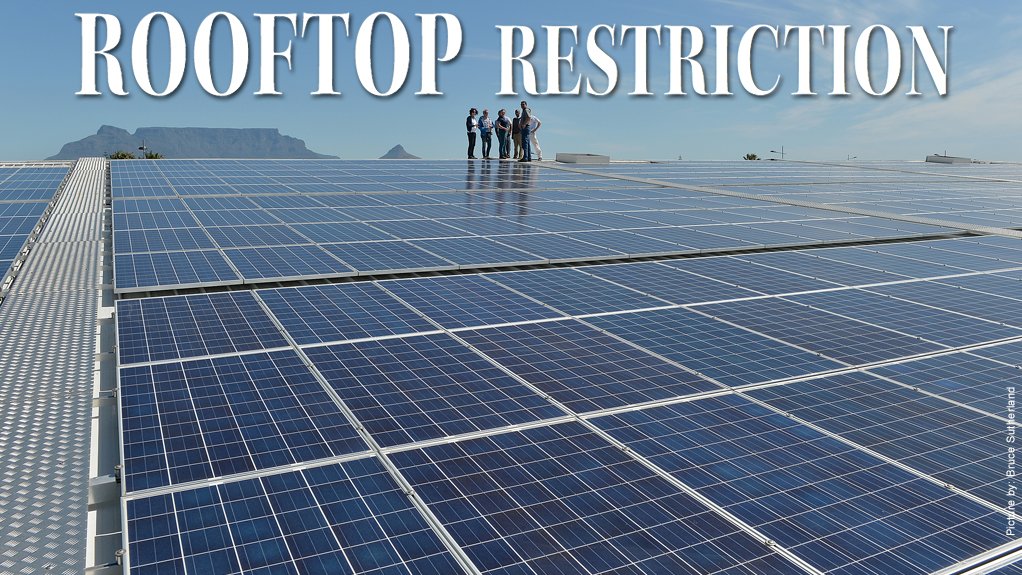Rules uncertainty curbing Cape Town’s embedded generation enthusiasm
Despite hurdles, Cape Town has surged ahead with alternative ways of procuring energy, with more businesses and households generating excess electricity and then feeding it back into the grid.
The City of Cape Town was given permission to be a pilot site for embedded generation, with its first projects taking off in 2014.
Since then, 18 commercial customers, including the V&A Waterfront, the Black River Park office complex and Bayside Mall, as well as 43 residential homes in Cape Town, are connected to the grid.
They are able to generate their own electricity and feed excess electricity into the city’s grid through solar photovoltaic (PV) panels on their rooftops. They are, in turn, rewarded for this.
“We see this as an important part of the green economy. It’s gaining traction. In the context of a national energy crisis and a national energy shortage, we want to promote it in a big way. The more power we bring on, the cheaper it will be in the long run,” says the City of Cape Town’s director of trade and investment, Lance Greyling.
Black River Park Investments, an office park in Observatory, Cape Town, was the first commercial firm to sign up for the small-scale embedded generation policy in 2014 and was the biggest solar installation in the entire southern hemisphere at the time, says Matthew Kempthorne, the chairperson of the city’s portfolio committee on energy and climate change.
The 74 000 m2 office park uses large-scale solar power systems to generate environmentally sustainable energy. Solar panels cover the equivalent of two rugby fields. Some of the electricity it produces is used to meet its own energy demands, while it feeds a limited amount of extra electricity back into the city’s grid in exchange for an offset against the park’s monthly electricity accounts. The electricity it saves over quiet weekends, when the load is reduced, is stored and fed back into the city’s grid.
But, despite the enthusiasm for the projects it is involved in, the city is in holding mode. The National Energy Regulator of South Africa (Nersa) was to have published the regulatory rules for small-scale embedded generation by the end of May last year. But it says it is still waiting for the Department of Energy to complete drafting the licensing regulations, which will provide a policy framework within which the Nersa regulatory rules will be formulated and applied.
“We’re still in a grey area when it comes to regulatory oversight. We are constrained by national legislation. We’re waiting for the department to come out with a policy position on what they will subsidise,” says Kempthorne.
A feed-in tariff is designed to boost investment in renewable-energy technologies by offering long-term contracts to renewable- energy producers. Renewable-electricity generators, from homeowners to business owners, are paid a cost-based price for the renewable energy they supply to the grid.
The system is working well for businesses that burn up a lot of energy during working hours.
“When they generate electricity during the day through solar panels, they’re using that immediately, and don’t need to buy electricity from us, while during weekends, when they can generate electricity without using it, we can buy it back at Eskom prices,” says Greyling.
He says embedded generation is a worldwide trend, and South Africa needs to position itself for the future.
“Instead of buying from Eskom, acting as middlemen and then selling to customers, we’re looking at various options. The utility model is being threatened across the world.”
A string of buildings in the popular V&A Waterfront has made the most of developments in renewable energy by moving swiftly into solar power.
Sustainable Power Solutions, which installed 4 200 SolarWorld Africa solar panels and SMA converters across key buildings throughout the V&A, has covered 7 500 m2 of roof area. The panels generate an average of 4 500 kWh a day – equivalent to powering 310 average households. They range from residential buildings such as the Breakwater Apartments to the Two Oceans Aquarium and the Clock Tower, and cover up to 24% of the total electricity consumption, depending on the building.
A grid-connected solar plant is connected to the city’s electricity grid. As solar is a complementary source of energy, it works in conjunction with the city’s electricity system. As there is so much consumption, the V&A is designed for its own electricity use. All the solar energy is consumed in the buildings, with none of it exported.
The V&A sees a benefit in the environmental sense, as it is able to avoid 1 600 t of carbon dioxide emissions a year. It also generates long-term electricity savings through its use of solar PV.
More Affordable
SolarWorld Africa MD Gregor Kuepper says prices of solar PV have sparked interest. “Prices are very affordable. The price of solar PV has come down substantially over the past ten years and is now at 65 c to 75 c per kilowatt hour. It’s a major price shift which would make the energy source fully [comparable to] the grid prices.”
Kempthorne says the city has been keeping a keen eye on the way Germany – a trailblazer in the field – has rolled out renewable technologies. Metering has also been pivotal.
Kuper suggests that keeping track of the solar energy produced is essential. Consumers have to install a bidirectional advanced meter at their own cost if they want to feed into the city’s power grid.
“You have to keep a record of what you produce through a meter installed next to the regular municipality meter. One meter shows what you take out of the grid, and the other meter shows what you feed into the grid.”
While feed-in schemes can be a boon for businesses, there’s not as much incentive for residences in South Africa at this stage. The cost of the metering system in particular is high, with the average household system costing around R200 000 once everything is installed and in running order, says Kempthorne.
The other challenge is that houses do not have as much electricity consumption during the daytime hours, when the solar panels are working their hardest. The surplus solar generated during daytime hours needs to be stored in battery banks, which are expensive. Homeowners also pay the city a network charge of R13 per day.
But Kempthorne expects that costs will come down as demand grows, while most people who have linked into the system are doing it mainly for environmental reasons.
Municipal Income?
There has also been concern that municipalities would lose out on valuable income if business and homeowners opt for the feed-in option. But Kempthorne says it will not reach a stage where those who cannot afford it will have to subsidise the wealthy.
“Strategically, the city wants to be the battery, and we will tailor-make our tariffs. We need to make a strategic decision to embrace the change but will need to tailor-make tariffs to protect our revenue.”
Cape Town Mayor Patricia de Lille sees the uptake of renewable-energy technologies as an opportunity to further build the economy.
“If we want to continue on the upward trajectory of economic growth and job creation in Cape Town, we need to act now to make our city and province energy secure.
“We cannot leave the future of energy security in the hands of Eskom. We no longer want to merely be distributors of electricity but want to become energy creators as well.”
While keen to expand its feed-in programme, the City of Cape Town has also issued guidelines on the safe and legal installation of rooftop PV systems and the importance of using a service provider capable of designing, supplying, installing and commissioning PV systems. This follows instances of poorly installed rooftop PV systems, while others were being connected to the electricity grid illegally.
The council has warned that people are at risk of electrical fires and electric shocks from poor-quality installations that do not meet the wiring standards, while the safety and power quality of the electricity grid could also be compromised by illegal connections. The municipality is also worried about unplanned generation capacity that the network is not designed to carry.
Any business or homeowner who wants to connect a PV system to the grid needs prior written approval from the City of Cape Town’s Electricity Services department. The business or homeowner also needs to be within the city’s electricity distribution area. The city distributes electricity to 75% of Cape Town, while Eskom distributes electricity directly to the remaining 25%.
The city has set a target of sourcing between 10% and 20% of its energy generation from renewable-energy sources by 2020.
Comments
Press Office
Announcements
What's On
Subscribe to improve your user experience...
Option 1 (equivalent of R125 a month):
Receive a weekly copy of Creamer Media's Engineering News & Mining Weekly magazine
(print copy for those in South Africa and e-magazine for those outside of South Africa)
Receive daily email newsletters
Access to full search results
Access archive of magazine back copies
Access to Projects in Progress
Access to ONE Research Report of your choice in PDF format
Option 2 (equivalent of R375 a month):
All benefits from Option 1
PLUS
Access to Creamer Media's Research Channel Africa for ALL Research Reports, in PDF format, on various industrial and mining sectors
including Electricity; Water; Energy Transition; Hydrogen; Roads, Rail and Ports; Coal; Gold; Platinum; Battery Metals; etc.
Already a subscriber?
Forgotten your password?
Receive weekly copy of Creamer Media's Engineering News & Mining Weekly magazine (print copy for those in South Africa and e-magazine for those outside of South Africa)
➕
Recieve daily email newsletters
➕
Access to full search results
➕
Access archive of magazine back copies
➕
Access to Projects in Progress
➕
Access to ONE Research Report of your choice in PDF format
RESEARCH CHANNEL AFRICA
R4500 (equivalent of R375 a month)
SUBSCRIBEAll benefits from Option 1
➕
Access to Creamer Media's Research Channel Africa for ALL Research Reports on various industrial and mining sectors, in PDF format, including on:
Electricity
➕
Water
➕
Energy Transition
➕
Hydrogen
➕
Roads, Rail and Ports
➕
Coal
➕
Gold
➕
Platinum
➕
Battery Metals
➕
etc.
Receive all benefits from Option 1 or Option 2 delivered to numerous people at your company
➕
Multiple User names and Passwords for simultaneous log-ins
➕
Intranet integration access to all in your organisation




















